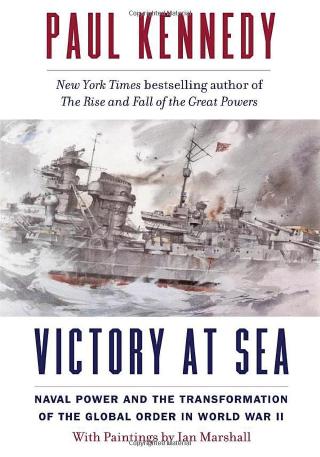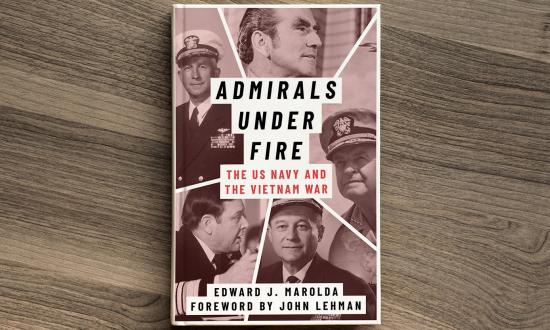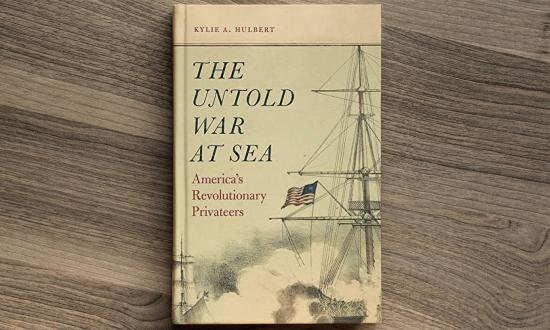Admiral Hyman Rickover: Engineer of Power
Marc Wortman. New Haven, CT: Yale University Press, 2022. 310 pp. Notes. Index. $26.
Reviewed by Commander Christopher Nelson, U.S. Navy
Admiral Hyman G. Rickover, the “Father of the Nuclear Navy,” remains one of the most controversial and fascinating admirals of the 20th century. The longest-serving officer in the Navy’s history, he was committed to the principle that man’s purpose in life is “to work, to create, to excel, and to be concerned about the world and its affairs.” His personality and work ethic and the technological revolution he forced on the Navy continue to offer historians and sailors insights. Historian and independent journalist Marc Wortman’s fine biography, Admiral Hyman Rickover: Engineer of Power, is the newest book on Rickover, his legacy, and the culture he built that lasts to this day.
Wortman’s book, coming in at slightly more than 300 pages, covers the man and his life in sufficient detail. Compared to some of the other biographies on Rickover—Norman Polmar and Thomas Allen’s Rickover: Controversy and Genius (Simon & Schuster, 1982), Francis Duncan’s Rickover: The Struggle for Excellence (Naval Institute Press, 2011), and Theodore Rockwell’s The Rickover Effect (iUniverse, 2002)—Wortman manages to offer an approachable work that is neither too long nor bogged down in the numerous bureaucratic scuffles Rickover fought throughout his life.
Wortman manages to cover all the significant periods of “Rick’s” long life in uniform: attending the U.S. Naval Academy; his time at sea leading up to command of the decrepit minesweeper USS Finch (AM-9); Admiral Earle Mills’s consequential decision to put Rickover on a small team to study nuclear power and its possible application for the Navy; the creation of the USS Nautilus (SSN-571); and, of course, Rickover’s passion to study and improve the U.S. education system.
If one has dipped into the other well-known biographies of Rickover, to also include Rear Admiral Dave Oliver’s fine memoir, Wortman’s book could be best described as a precise synthesis—a nice selection from each milestone in Rickover’s long professional life. For instance, while Polmar and Allen’s biography, coming in at more than 700 pages, discusses Rickover’s time at the Naval Academy in 20 pages, Wortman boils it down to three or four, hitting all the high points. Indeed, a scan of the bibliography shows that Wortman has used some of these texts to fine effect, finding the gems in each.
Also, Wortman sprinkles in the colorful anecdotes and quotes that make Rickover such a unique figure in naval history. And while Wortman does not go into the detail other authors have on Rickover’s famous interviewing techniques, he still ably captures the experience dreaded by many nuclear officer aspirants in a chapter titled “The Chair with the Short Legs.”
Wortman does bring to light two things other Rickover biographies have not. The first is his birthdate. Rickover believed he was born on 27 January 1900. It is the date inscribed on his headstone in Arlington National Cemetery. Many immigrants in the late 19th and early 20th century did not know the exact date of their birth. Wortman’s intrepid researcher and cousin, however, discovered Admiral Rickover was actually born a month earlier—on 24 December 1899.
Second, in interviews with the Jewish chaplain who “walked the decks” at Bethesda Naval Hospital, it was revealed that Rickover’s second wife, Eleanore, claimed her husband never converted from Judaism. Even his only son, Robert, believed his father had converted to Christianity.
There is only one quibble with the book—a selection of pictures would have been a nice addition. Rickover made the cover of Time magazine and was photographed frequently. He was regularly in a suit and tie and of small stature, so the contrast of his oversized personality with his physical appearance makes for an interesting juxtaposition. No matter, Wortman’s Engineer of Power is a nice addition for the naval historian, enthusiast, or the spouse or parent of a naval professional who is interested in Rickover, yet wants a crisp, comprehensive read that can easily be knocked out in a few afternoons.
CDR Nelson is the deputy senior naval intelligence manager for East Asia in the Office of Naval Intelligence in Suitland, Maryland. He is a career naval intelligence officer and graduate of the U.S. Naval War College and the Maritime Advanced Warfighting School in Newport, Rhode Island.
Victory at Sea: Naval Power and the Transformation of the Global Order in World War II
Paul Kennedy. Illustrated by Ian Marshall. New Haven, CT: Yale University Press, 2022. Maps. Charts. Tables. Notes. Biblio. Index. $37.50.
Reviewed by David F. Winkler
Midway? Guadalcanal? Historians have made the case for one or the other—some both—as the turning point in the war in the Pacific for the United States. However, Paul Kennedy argues that pivotal date occurs in 1943—1 June, to be specific—when the USS Essex (CV-9) arrives at Pearl Harbor.
The Essex represents the bow wave of the American industrial engine kicking in. From here on out, a new carrier—the new lead measuring stick of sea power—began joining the fleet at a rate of one a month until the end of the war 26 months distant. Kennedy points out that even after their withdrawal from Guadalcanal, the Japanese still maintained naval superiority in the Pacific, noting that in early 1943 the Americans had to turn to the British to provide HMS Victorious to augment the USS Saratoga (CV-3)—the lone U.S. flattop remaining in the South Pacific.
Although his thesis is that sheer U.S. economic and industrial might would prove triumphant, Kennedy also pays homage to the Churchillian perspective that the turning point of the war actually came earlier, on 7 December 1941, with the U.S. entry into the conflict.
The Pacific turning point is but one of several thought-provoking observations in a volume that describes sea power’s role in a tectonic shift in global power from 1936 to 1945. Kennedy opens with an analysis of the world’s six leading naval powers—Great Britain, the United States, Japan, France, Italy, and Germany. With battleships remaining as the measuring stick of naval might, the Royal Navy still retained a global lead at the start. Kennedy’s opening chapters not only serve as a ship-counting exercise, but also explain the philosophical approach behind each nation’s fleet-building strategies. Here, Alfred Thayer Mahan and Sir Julian Corbett are explained with refreshing clarity.
Of course, geography is a key component in the story. In World War I the British kept the German High Seas Fleet trapped within the confines of the North Sea, but Germany’s bold seizure of Norway and the fall of France changed the equation in World War II. In contrast, Italy was confined to the restricted waters of the Mediterranean—a theater of the war oft overlooked by American scholars. Kennedy corrects this slight by providing this theater near coequal status with the Atlantic and Pacific.
Of the three theaters, it is the Atlantic that gets the most attention if but for the simple fact that the war begins in this theater more than two years before the attack on Pearl Harbor, four of the six naval powers discussed are based in this region, and though Kennedy places the turning point sometime in May 1943, German U-boats are still putting up a fight in the spring of 1945, even as Russian armies are approaching Berlin.
It is in this theater where we see an interesting quirk in Kennedy’s analysis about overwhelming U.S. industrial mobilization being the ultimate outcome decider. Whereas Craig Symonds and others point to bar graphs that show that the Americans were building cargo tonnage faster than the Germans were sinking it, Kennedy doubles down with the argument that the Battle of the Atlantic was won at sea. He points to the attack on convoy ONS 5 returning from Europe in May 1943, citing the effective employment of short-range radar by British escorts to fend off upward of 40 attacking submarines. Though the convoy lost 13 merchantmen, the loss of six U-boats and damage to seven more caused Admiral Karl Dӧnitz to call off the attacks and take time to recalibrate.
To write a book as broad in scope as this, the author drew from the works of scores of acclaimed scholars and rewards readers with his assessments of these writings in his endnotes. He also uses Wikipedia—that source long scorned within the academic community. Kennedy not only cites Wikipedia for source material in his endnotes, but highlights Wikipedia passages in his text—and why not? Wikipedia entries have become increasingly substantive in quality, complexity, and detail.
In a war at sea as grand in scale as World War II there are bound to be some voids in the narrative. Two stand out for this reviewer. Whereas the Imperial Japanese Navy expedition into the Indian Ocean in early 1942 is well covered, there is no mention of the raids conducted in the Marshalls and Gilberts by the USS Lexington (CV-2), Enterprise (CV-6), and Yorktown (CV-5), or the famed Doolittle Raid launched from the USS Hornet (CV-8) that would win Admiral Isoroku Yamamoto support for his bold Midway gambit. Of lesser note, the U.S. Navy conducted Operation Teardrop—a huge anitsubmarine warfare effort—in April 1945 to snuff out German U-boats that were thought to be carrying V-1 missiles or rockets to be targeted against East Coast cities. Of the nine deployed from Norway, the U.S. hunter-killer groups claimed five.
While a previous century found Mahan’s Influence of Sea Power on the bridges and wardrooms of many of the world’s fleets, Victory at Sea is worthy of similar treatment. Added icing is a portfolio of watercolors by deceased marine artist Ian Marshall. Marshall’s art combined with Kennedy’s prose makes this volume a most desirable acquisition.
Dr. Winkler is the staff historian with the Naval Historical Foundation.







